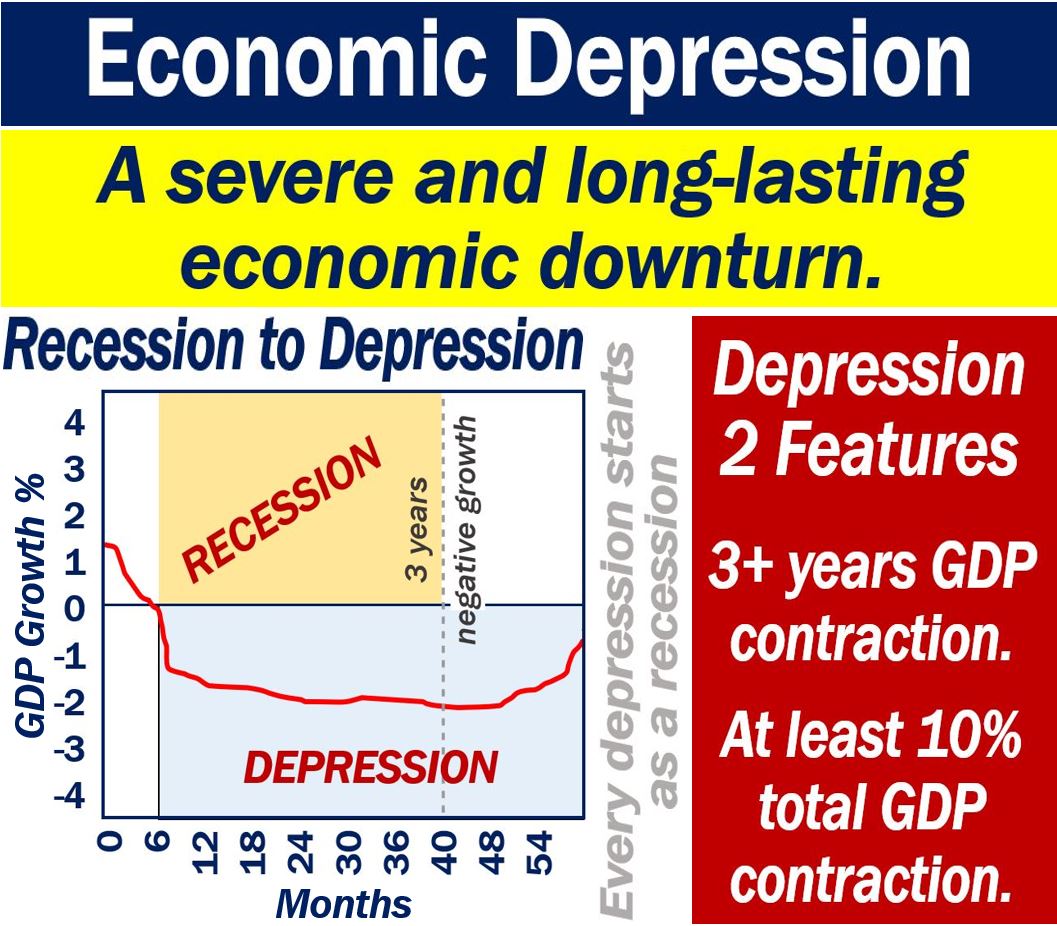An Economic Depression is a long period during which the economy does not grow, and unemployment remains very high. We often refer to it simply as a ‘depression.’ It is a more severe and longer-lasting form of recession. During an economic depression, unemployment rises and stays high. Also, there are too few jobs. There are many credit defaults, declining incomes, and often deflation. Economic activity is significantly lower than normal. In some cases, the country’s currency also devalues.
The term ‘default’ refers to a debtor’s failure to repay a loan. A debtor is somebody who is in debt, i.e., they owe money.
Put simply; an economic depression is a sustained, long-term decline in economic activity.
TheBalance.com has the following definition of the term:
“An economic depression is a severe downturn that lasts several years.”

Diagnosing an economic depression
We define a recession as two consecutive quarters of negative GDP growth. In other words, if the economy has been shrinking for at least six months, we have a recession.
Determining what an economic depression is, however, is not so clear. Very few sources tell us exactly what a depression is. They all say the same: “A depression is more severe and longer-lasting than a recession.”
In a 2008 article about the definition of depression in the Economist titled ‘Diagnosing Depression,’ the author writes:
“So how severe does this current slump have to get before it warrants the ‘D’ word?”
The author searched on the Internet and found two principal criteria for distinguishing an economic depression from a recession:
- GDP must shrink by at least 10% (total GDP contraction).
- The economic downturn must last longer than three years.
Economic depression – 20th century
The US, UK, and other advanced economies have not suffered an economic depression for several decades. In modern history, in fact, they have only experienced one, i.e., the Great Depression. In this context, ‘modern history’ means ‘since the beginning of the 20th century.’
-
The Great Depression
The Great Depression occurred mostly during the 1930s. It began soon after the 1929 Wall Street Crash, when the stock market collapsed.
The Great Depression affected the United States, and also many other countries across the world. However, it hit the US first.
It was the deepest, longest, and most widespread economic depression of the 20th century.
From 1929 to 1932, global GDP fell by about 15%. This was much more than the 1% decline during the Great Recession, which started in 2008.
GDP stands for gross domestic product. It represents everything we produce over a specific period.
We call the 1930s economic downturn a depression but the 2008/9 one a recession. Depressions are much more severe than recessions. They also last longer.
-
The Great Depression – USA
In the US, unemployment reached 25% in early 1933. A severe drought persisted and households, farmers, and businesses defaulted on loans in record numbers.
Between 1929 and 1933, more than five thousand banks failed.
Hundreds of thousands of American families became homeless. They started congregating in Hoovervilles, i.e., shanty towns that sprouted all over the country.
The wages of workers with jobs fell by forty-two percent. US GDP fell from $103 billion to $55 billion. The GDP collapse was partly due to deflation.
Each year, during the economic depression, prices fell by ten percent annually.
-
The Great Depression – UK
The economic depression also hit the UK, which had still not recovered fully from the effects of WWI.
Things got so bad that the British government had to remove the country from the gold standard in 1931.
A steep decline in orders hit industrial areas of the country hard. Within two years, unemployment rose from 1 to 2.5 million, while exports declined by 50%. One-fifth of the insured workforce had no job.
In Glasgow, one-third of the adult population was unemployed due to the collapse of heavy industries.
Shipbuilding fell by 90%. In some north-east cities and towns, unemployment reached 70%.
Regarding other parts of the country, Wikipedia writes:
“In the less industrial Midlands and Southern England, the effects were short-lived and the later 1930s were a prosperous time.”
“Growth in modern manufacture of electrical goods and a boom in the motor car industry was helped by a growing southern population and an expanding middle class.”
The repercussions of an economic depression extend beyond simple economic indicators, deeply affecting the social fabric and mental health of the population.
Emerging economies
The emerging economies are much more prone to economic depressions than the advanced ones.
The Economist covers 25 emerging economies each week in its back pages. During the past three decades, thirteen of those economies have experienced GDP contractions exceeding 10%.
Poland and Argentina, for example, have each experienced an economic depression twice in thirty years.
Between 1990 and 1998, Russia went through an economic depression which contracted GDP by 45%.
Compound phrases that describe the economy
There are many compound phrases that describe the health of the economy. A compound phrase is a term that contains at least two words: Let’s have a look at some of them:
-
Economic Boom
A period of significant economic growth.
Example: “The country’s technological sector led to an economic boom.”
-
Economic Downturn
A slowdown in economic activity.
Example: “Manufacturers cut production during the economic downturn.”
-
Economic Recession
A decline in economic activity across the economy.
Example: “Policy makers implemented stimulus measures to counter the economic recession.”
-
Economic Recovery
The period following a recession during which the economy grows.
Example: “Job markets strengthened during the economic recovery.”
-
Economic Bubble
An economic cycle characterized by the rapid escalation of asset prices.
Example: “The housing market experienced an economic bubble that eventually burst.”
Video – What is an Economic Depression?
This educational video comes from our sister channel – Marketing Business Network. It explains what “Economic Depression” means using easy-to-understand language and straightforward examples.
